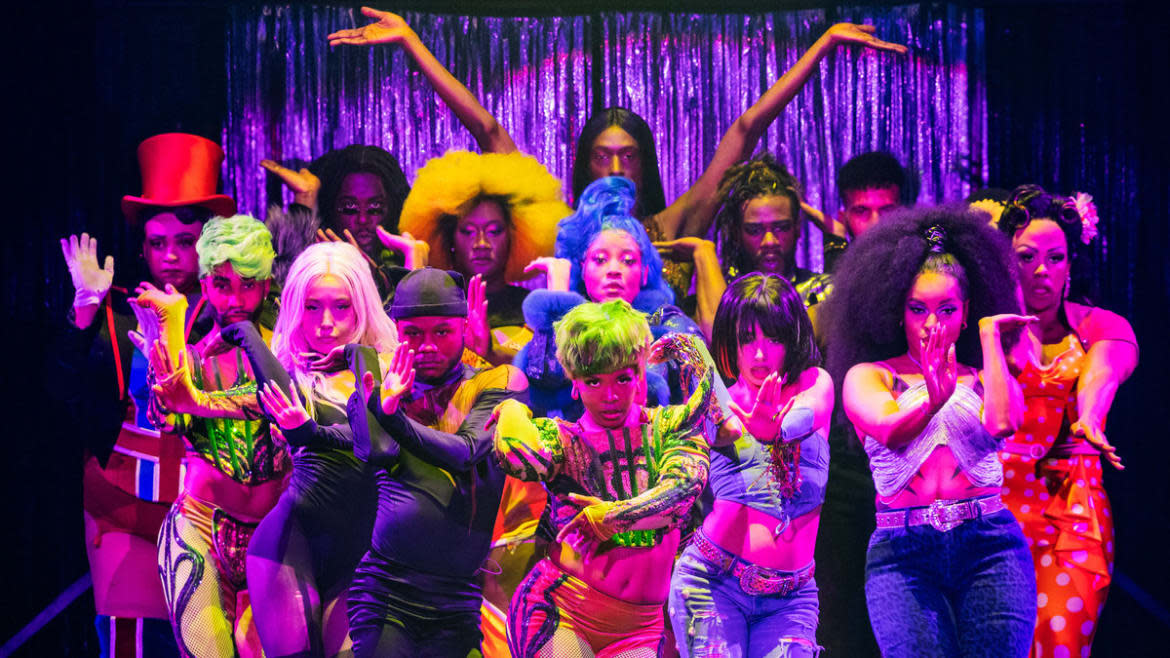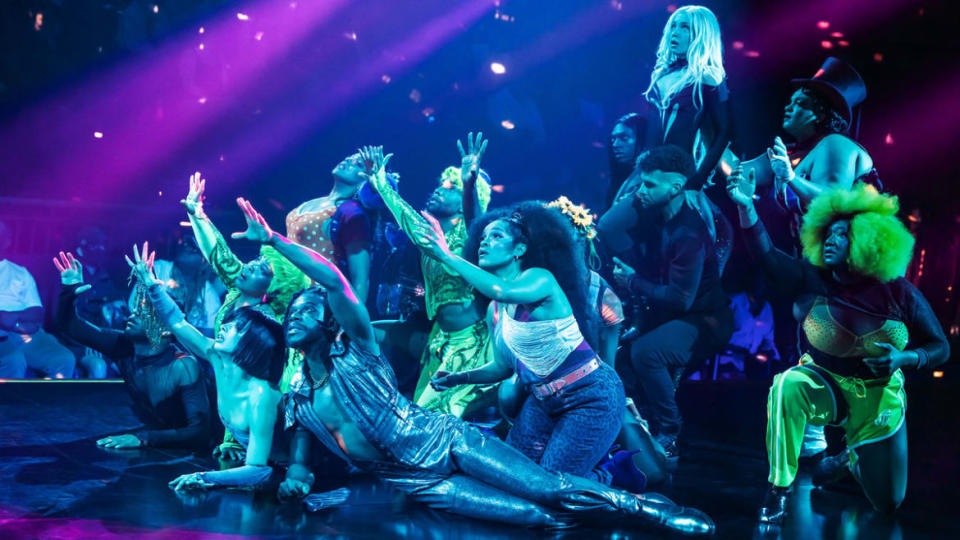Any ‘Cats’ Haters Will Be Instantly Cured by ‘Cats: The Jellicle Ball’

For this critic, Cats can do no wrong. That declaration is written in the knowledge that Andrew Lloyd Webber’s musical is deeply unloved by many—a benighted status rooted in miaowing mockery, which was only worsened by the much-lambasted 2019 movie (which again, sorry, not sorry, kept me more rapt than revolted).
So, while the fabulous Cats: The Jellicle Ball (PAC NYC, to Jul. 28) doesn’t need to change my opinion, it may change others; witness the ecstatic response to the promotional video for the show released in May, and then also witness the response to the show itself. My left ear is still recovering from being whooped and shrieked into at decibel-shattering volume by the person sitting next to me.
To be fair, the audience is instructed to be as loud as they like; for now the setting is not a junkyard of prowling felines in singing competition to ascend to the Heaviside Layer, but an exuberant celebration of queer Ballroom culture. It’s a thematic twist, and also a concordance, that works brilliantly—and keys into a contemporary awareness of the history of underground scene that was showcased by the TV series Pose.
‘Cats’ Is Back on Broadway and It’s Irresistible
“Think about ‘Cats’ being street characters in a junkyard and ballroom being these historically marginalized people,” Zhailon Levingston, the show’s co-director, told The New York Times. “In ballroom, you have a centering of legacy and chosen family, the way cats have a tribe. Both take what’s given to them, and turn it into something beautiful.” As the dual-applied instruction flashes up in front of us: “Come out.”
The interior of the Perelman Performing Arts Center’s theater is dominated by a 57-foot runway designed by Rachel Hauk, while the musical remains mostly untouched, bar the addition of “a few ballroom references,” the Times reported. “We want this production to be authentic to Andrew Lloyd Webber’s Cats, to T.S. Eliot’s words and to ballroom,” co-director Bill Rauch told the Times. “All those things are of equal weight and importance to us. If there’s a ballroom choice that doesn’t honor the musical, or a musical choice that doesn’t honor ballroom, then we don’t do it.”
Ballroom and junkyard, and cats and queens, turn out to be exceedingly complementary. For one, they know to pose, slink, and stand their ground. They want love, but they want their own territory. They love to be admired, even venerated, but on their own terms. Watch them preen and arch, they want your gaze—but don’t stand too close. They are independent, fiercely so; every cat, like every queen is uniquely singular. And, under attack or on display as a group, they are an intimidating, glorious collective.
Qween Jean’s costumes—riotous glitter, insane colors, and drama-streaked silhouettes—are the finest costumes on or off Broadway right now. Choreographers Arturo Lyons and Omari Wiles and dance captain Baby serve up a feast of movement that takes in ballroom, nods to the Cats original, pop, and modern ballet.
Here, as the queens sing and dance for their deliverance, they are also singing for their own difference and power. Occasionally, we hear police sirens—the ever-present threat of the law setting out to regulate and crush marginalized queer lives and modes of self-expression. The coding of the cats matches the coding of the queens; if Cats has a through-line it is about the parallel lines of young and old, and here the older queens are involved in a complex dance with their own youth and the youth around them. The runway and sides of the theater become playgrounds and dance-offs, pose-downs and meditation spaces, and interactions with the audience; one criticism is the space feels oddly too spacey and unoccupied at times. The cast do all they can to valiantly fill it.
At the beginning of act two the thematic heart of the production is revealed; as “Moments of Happiness” plays, we watch a collage of images of legends of real-life queer Ballroom history: William Dorsey Swann, Willie Ninja, Junior Labejia, Marsha P. Johnson, Octavia St Laurent, and Tracy Africa. The founding mothers of the NYC Ball Houses starting in 1969/1970 are also celebrated: Crystal Labejia, Pepper Labejia, Paris Dupree, Avis Pendavis, Angie Xtravaganza, Dorian Corey, and Duchess La Wong. Just as Cats asks its young audience to know and respect its elders, so this moment too demands, rightly, of us.

The company of 'Cats: The Jellice Ball.'
The younger cast are all brimming fun and energy machines, lighting up the stage with big numbers like “Jellicle Songs for Jellicle Cats” (yes, I am still humming it 24 hours later), “Bustopher Jones: The Cat About Town,” “Mungojerrie and Rumpleteazer” (Jonathan Burke and Dava Huesca, having their own dizzyingly fun ball), “Skimbleshanks: The Railway Cat” (an excellent Emma Sofia) and “Macavity: The Mystery Cat.”
Antwayn Hopper as Macavity revels in his character’s swagger, and the audience revels in his reveling. Dudney Joseph Jr. as Munkustrap is a coolly charismatic Master of Ceremonies, and Sydney James Harcourt as Rum Tum Tugger is his own bonfire of attractive vanities. Robert “Silk” Mason as the Magical Mister Mistoffelees is a lithe, high-kicking pillar of sparkle, and that lilting song becomes its own cross-generational melody, a theater of whooping and delighted cries momentarily changes to one of a chorus of sweetly light singing-along.
Within a uniformly excellent cast, André De Shields is a lovely Old Deuteronomy, grand, wise, and taking absolutely no shit—he is the only cat who can cool Macavity’s sexily narcissistic jets with a simple raise of the hand. Gus the Theater Cat is played by Paris Is Burning star Junior Labeija, the younger queens hanging on his every word about the stages he has played and stars he has acting alongside.
“Tempress” Chasity Moore plays Grizabella as the diva facing mortality with the tragic poise you initially expect, but then add the experience of being trans, of being a trailblazer, of facing first the disdain of the young and then—after “Memory” has been heartbreakingly, rather than beltingly rendered—with their respect and love, as Grizabella sets off on their next journey of mysterious transformation.
Cats remains eternally weird, but in this new, queer incarnation it makes a fresh, affirming, piercingly moving sense. That is most evident in its famous final address—in the Lloyd Webber original it is a resonant, if surreal assertion of cat identity; here it is as resonant an assertion of Black and Brown queer bodies and identities, of joy, defiance, mischief, and of a resolutely enshrined history and celebration of lives lived epically and colorfully in the margins, flourishing out of conventional sight. Get down to the Perelman, Cats haters—and be transformed.
Get the Daily Beast's biggest scoops and scandals delivered right to your inbox. Sign up now.
Stay informed and gain unlimited access to the Daily Beast's unmatched reporting. Subscribe now.

 Yahoo News
Yahoo News 
